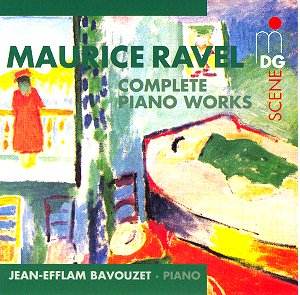Ravel was fastidious
composer, slow, deliberate and painstaking
about detail. Consequently his output
is relatively small yet exceedingly
high in craftsmanship and musical quality.
It may surprise people to know that
Ravelís total output for solo piano
spans just over 130 minutes and the
MDG label have accommodated the complete
works on this double CD set played by
the outstanding soloist Jean-Efflam
Bavouzet.
Ravelís earliest piano
works are dominated by impressionism
and it is generally acknowledged that
in 1901 Ravel composed the first ever
impressionist work for piano with Jeux
díeaux (Fountains). The work brought
the composer considerable success and
on this release piano soloist Jean-Efflam
Bavouzet makes a fine job of portraying
Ravelís images of the music and sounds
of fountains, waterfalls and streams.
The extended arpeggios pitted against
dreamy harmonies are most convincing.
In 1899 Ravel composed
his celebrated Pavane pour une infante
défunte, which was conceived
as a delicate and tender portrait of
old Spain with a sensuous Debussian
flow imposed on an old dance form. The
Pavane remains Ravelís most popular
composition especially in his 1910 orchestration.
The sheer sound that Bavouzet draws
from his Steinway D piano manufactured
in 1901 is ravishing and a real highlight.
Composed in 1905, for
a competition conducted by a music journal,
the three movement Sonatine is
acknowledged as one of Ravelís finest
piano compositions. Bavouzet is particularly
impressive in the surging passion of
the first movement Modéré
and the nervous exuberance of the Animé
finale.
At nearly thirty minutes
in duration Miroirs from 1905
is Ravelís largest piano work and also
arguably his most daring as he entered
a new phase of development. Bavouzet
skilfully moves across to this freer
and more varied style with more extended
developments. Ravel uses five pieces
which are designed to reflect their
subjects, inspired by external images
as mirrored in sound. For example in
the second piece Oiseaux tristes
the music is symbolic never attempting
to imitate bird song. Soloist Bavouzet
gives a most sensitive portrait of the
extensive palette of colours in Ravelís
musical description of the changing
sea in Une barque sur líocéan.
Bavouzetís delicate blend of irony and
tone painting is impressive and compelling
in the famous Alborada del gracioso.
Originally intended
as a musical tribute to the harpsichord
music of François Couperin-le-Grand
the celebrated Le Tombeau de Couperin
was Ravelís final work for solo
piano. Composed between 1914 to 1917
Ravel was to dedicate this set of six
pieces in honour of friends that had
died in the Great War. Ravel was further
affected by the death of his mother
at this time yet there is no trace of
pity or melancholy under the surface
of the music. Essentially a neo-classical
work Bavouzet in successful is performing
the work with all the necessary seventeenth
century economy and transparency and
really communicates a sense of tranquillity
in the spirit of a by-gone age.
In 1908 Ravel was inspired
to compose three descriptive pieces
for piano by the poems of Aloysius Bertrand
under the collective title of Gaspard
de la Nuit. In this fantasy world
of gnomes, elves and ghosts the first
piece of the trilogy Ondine reproduces
the sound of water. Le Gibet is a musical
portrait of the gallows and the final
piece Scarbo is an ironic scherzo
representing a will-o-the-wisp. Bavouzet
makes light work of the technical demands
and provides a spontaneous, almost improvisatory
feel of harrowing immediacy.
Franz Schubertís piano
waltzes were the inspiration behind
Ravelís Valses nobles et sentimentales
composed in 1911. The cycle consists
of seven pieces which follow each other
directly, with an additional epilogue.
With bold harmonies Bavouzet impressively
conveys the rhythms with the pulse and
lilt of the Viennese waltzes.
Bavouzet is clearly
in love with this music. He provides
the perfect atmosphere and is consistently
impressive in the several shorter works
on this release; in particular the Sérénade
grotesque and the Menuet antique.
There are several illustrious
alternative versions in the catalogue
of the complete piano works of Ravel
which are all highly recommendable.
Notably the sets from heavyweight artistes
such as: Pascal Roge on Double Decca
440 836 2; Louis Lortie on Chandos CHAN
7004/7; Jean-Yves Thibaudet on Decca
433 515-2; Jean-Philippe Collard on
EMI CES5 72376-2 and Angela Hewittís
recent survey on Hyperion CDA 67341/2.
I have no hesitation in stating that
Jean-Efflam Bavouzetís masterly interpretations
on MDG can stand equally alongside the
very best of these distinguished versions.
Bavouzet plays with such remarkable
authority, expressive strength and unadulterated
brilliance. The soloistís phrasing seems
to transcend beyond Ravelís markings
on the page and allows the musical line
to breathe in a natural, almost conversational
way.
Assisted by the splendid
sound quality provided by MDGís natural
acoustics and the comprehensive booklet
notes, this recording challenges the
best around. Jean-Efflam Bavouzet is
one of Franceís best kept secrets. In
fact Bavouzetís playing is restricted
to a most narrow range; wonderful to
superb.
Michael Cookson
